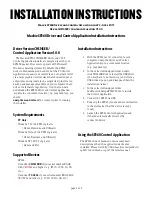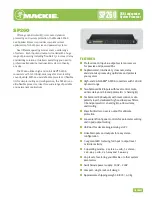
Architecture
1031
SPRUH82C – April 2013 – Revised September 2016
Copyright © 2013–2016, Texas Instruments Incorporated
Liquid Crystal Display Controller (LCDC)
23.2.1.2 Horizontal Clock (LCD_HSYNC)
LCD_HSYNC toggles after all pixels in a horizontal line have been transmitted to the LCD and a
programmable number of pixel clock wait states has elapsed both at the beginning and end of each line.
The RASTER_TIMING_0 register fully defines the behavior of this signal.
LCD_HSYNC can be programmed to be synchronized with the rising or falling edge of LCD_PCLK. The
configuration field is bits 24 and 25 in the RASTER_TIMING_2 register.
•
Active (TFT) mode.
The horizontal clock or the line clock is also used by TFT displays as the
horizontal synchronization signal (LCD_HSYNC).
The timings of the horizontal clock(line clock) pins are programmable to support:
•
Delay insertion both at the beginning and end of each line
•
Line clock polarity.
•
Line clock pulse width, driven on rising or falling edge of pixel clock.
23.2.1.3 Vertical Clock (LCD_VSYNC)
LCD_VSYNC toggles after all lines in a frame have been transmitted to the LCD and a programmable
number of line clock cycles has elapsed both at the beginning and end of each frame.
The RASTER_TIMING_1 register fully defines the behavior of this signal.
LCD_VSYNC can be programmed to be synchronized with the rising or falling edge of LCD_PCLK. The
configuration field is bits 24 and 25 in the RASTER_TIMING_2 register.
•
Passive (STN) mode.
The vertical clock; that is, the frame clock, toggles during the first line of the
screen.
•
Active (TFT) mode.
The vertical clock, that is, the frame clock, is also used by TFT displays as the
vertical synchronization signal (LCD_VSYNC).
The timings of the vertical clock pins are programmable to support:
•
Delay insertion both at the beginning and end of each frame
•
Frame clock polarity
23.2.1.4
LCD_AC_ENB_CS
•
Passive (STN) mode.
To prevent a dc charge within the screen pixels, the power and ground supplies
of the display are periodically switched. The Raster Controller signals the LCD to switch the polarity by
toggling this pin (LCD_AC_ENB_CS).
•
Active (TFT) mode.
This signal acts as an output enable (OE) signal. It is used to signal the external
LCD that the data is valid on the data bus (LCD_D[15:0]).
















































